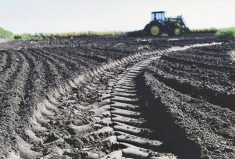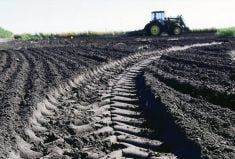Soil carbon concentration has decreased since the 1950s but the plow layer has deepened and diluted the carbon content.
This makes it difficult to accurately compare carbon concentrations as a dilution factor must be considered, say researchers at the University of Guelph.
“That is not the only factor contributing to that decrease in carbon concentration but it’s important to take into consideration,” says James Warren with the School of Environmental Sciences at the University of Guelph.
Read Also

Senft to step down as CEO of Seeds Canada
Barry Senft, the founding CEO of the five-year-old Seeds Canada organization is stepping down as of January 2026.
Why it matters: The concentration of soil organic carbon contributes to the health of the soil and its ability to grow healthy crops.
It has been decreasing for many years and large amounts of that may be attributed to the dilution of the carbon into a larger volume of topsoil.
While redoing the soil maps of Ontario in 2016-18, Adam Gillespie, assistant professor with the School of Environmental Sciences at the University of Guelph, and other researchers, noticed a consistent increase in the depth of the plow layer over a span of almost 70 years.
The plow layers were almost 30 centimetres deep, says Gillespie. A lot of the time topsoil layers are only considered to be 15 centimetres deep, or six inches.
Increased size of equipment over the years has contributed to the increase in plow layer depth. As the equipment becomes larger, so does the tillage depth.
Researchers began to wonder, “if your topsoil is getting deeper, what does that really mean for carbon content?”
Even though carbon concentrations have dropped by 0.5 per cent over the past 70 years, the carbon stock levels have stayed relatively consistent as the topsoil horizons have increased in size by about 40 per cent.
These changes equate to a 0.008 per cent decrease in soil organic carbon per year over the past 70 years with the average thickness of the plow layer moving deeper by 0.1 cm per year.
As outlined in a paper written by Warren, Gillespie, and Dan Saurette, pedologist with the Ontario Ministry of Agriculture, Food and Rural Affairs, their findings show that a soil sample containing four per cent organic carbon in a 0–15 cm thick topsoil in the 1950s would equate to two per cent organic carbon today with a net loss of zero carbon.
The decrease would be attributed to a dilution because of the increase in cultivated topsoil.
“This observation demonstrates that direct comparison of organic carbon levels on a percentage basis with time is not an accurate means of comparison.”
It is suggested by researchers in the paper that comparisons of soil organic carbon over the past 70 years should include a depth component and “should be expressed on a carbon storage basis” such as tonnes per hectare.
Although the levels are staying consistent, the dilution of the carbon does not create ideal growing conditions for plants or soil health.
“As we dilute the carbon into a deeper plowed layer, we’re not getting the benefits that we want to see from organic matter. If it is less concentrated it’s impacting things like your nutrient supply or your water-holding capacity,” says Gillespie.
The conversation around managing soil carbon is still important.
“I think what we’re finding is that the idea of the carbon stocks being built up isn’t as dire as we might have thought. Nevertheless, we’re still working to try and keep those carbon numbers going up. You can still get those benefits from having higher organic matter in soils,” says Gillespie.















